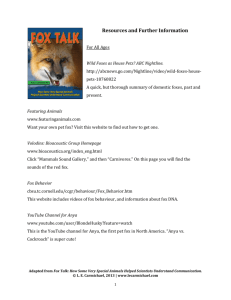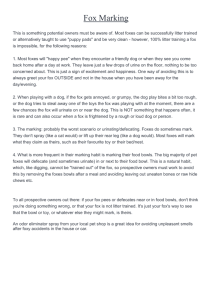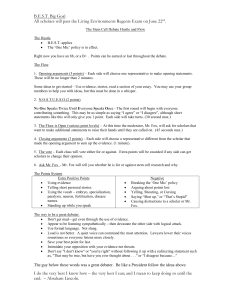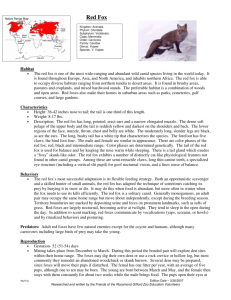The Gray Fox - American River Natural History Association
advertisement
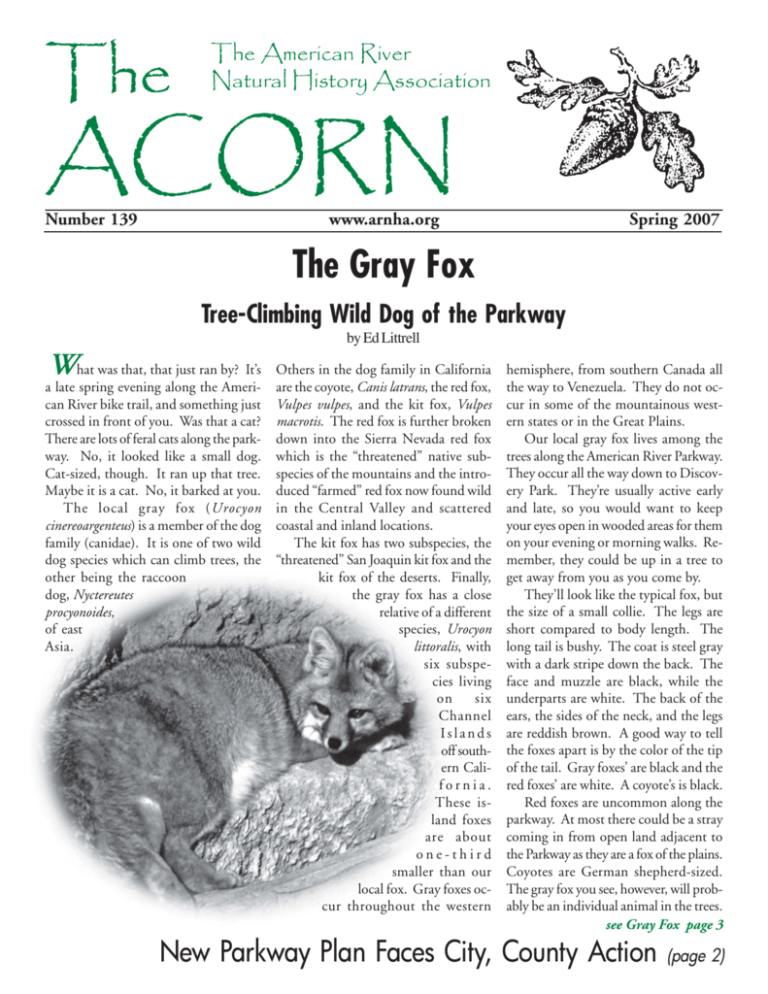
The The American River Natural History Association ACORN Number 139 136 www.arnha.org Spring 2007 2006 The Gray Fox Tree-Climbing Wild Dog of the Parkway by Ed Littrell What was that, that just ran by? It’s a late spring evening along the American River bike trail, and something just crossed in front of you. Was that a cat? There are lots of feral cats along the parkway. No, it looked like a small dog. Cat-sized, though. It ran up that tree. Maybe it is a cat. No, it barked at you. The local gray fox (Urocyon cinereoargenteus) is a member of the dog family (canidae). It is one of two wild dog species which can climb trees, the other being the raccoon dog, Nyctereutes procyonoides, of east Asia. Others in the dog family in California are the coyote, Canis latrans, the red fox, Vulpes vulpes, and the kit fox, Vulpes macrotis. The red fox is further broken down into the Sierra Nevada red fox which is the “threatened” native subspecies of the mountains and the introduced “farmed” red fox now found wild in the Central Valley and scattered coastal and inland locations. The kit fox has two subspecies, the “threatened” San Joaquin kit fox and the kit fox of the deserts. Finally, the gray fox has a close relative of a different species, Urocyon littoralis, with six subspecies living on six Channel Islands off southern California. These island foxes are about one-third smaller than our local fox. Gray foxes occur throughout the western hemisphere, from southern Canada all the way to Venezuela. They do not occur in some of the mountainous western states or in the Great Plains. Our local gray fox lives among the trees along the American River Parkway. They occur all the way down to Discovery Park. They’re usually active early and late, so you would want to keep your eyes open in wooded areas for them on your evening or morning walks. Remember, they could be up in a tree to get away from you as you come by. They’ll look like the typical fox, but the size of a small collie. The legs are short compared to body length. The long tail is bushy. The coat is steel gray with a dark stripe down the back. The face and muzzle are black, while the underparts are white. The back of the ears, the sides of the neck, and the legs are reddish brown. A good way to tell the foxes apart is by the color of the tip of the tail. Gray foxes’ are black and the red foxes’ are white. A coyote’s is black. Red foxes are uncommon along the parkway. At most there could be a stray coming in from open land adjacent to the Parkway as they are a fox of the plains. Coyotes are German shepherd-sized. The gray fox you see, however, will probably be an individual animal in the trees. see Gray Fox page 3 New Parkway Plan Faces City, County Action (page 2) ARNHA Board of Directors Larry Washington President Lee Wilner Vice President, Membership Peggy Kennedy Vice President, Newsletter Pete Hayes Vice President, Publications Claudia Hulbe Recording Secretary Paula Baldi Corresponding Secretary Roberta Wilner Treasurer Members at Large Cindy Dunning Marilee Flannery Bruce Kennedy Linda Thomas Greg Voelm Jamie Washington Walt Wiley Associate Members Katie Baygell Bill Dillinger Carol Doersch Bud Getty Lou Heinrich Mia Hershiser Timothy Howe Georgia Jones Molly Keller Ed Littrell Diana Parker Kip Skidmore Jo Smith Lynn White Representatives to other groups: Commission on History and Science Greg Voelm Parkway Advisory Committee open Parkway Master Plan Revision Committee Lou Heinrich American River Parkway Coalition Lou Heinrich Save the American River Ass’n. Bud Getty ARNHA American River Natural History Association P.O. Box 241 Carmichael, CA 95609 (916) 489-4918 • www.arnha.org The ACORN is published quarterly by ARNHA, a 501(c)3 nonprofit organization 2 Larry Washington Named ARNHA Interim President Larry Washington, a member of the ARNHA Board of Directors for more than three years, was elected interim president at a Board meeting Jan. 10. He succeeds President Noah Baygell, who resigned for personal reasons after more than three years of environmental activism marked by energy, innovation, and achievement. Larry will serve as interim president until the annual meeting in June when ARNHA officers and board members are elected With Bachelor degrees in architecture and environmental design from the University of Oklahoma, Larry is founder and principal of Two Rivers Architects, a Folsom-based architectural firm that has designed award-winning schools and other buildings for the past 30 years. He has contributed his talents to design work upgrading the seven Parkway informational kiosks managed by ARNHA and the county. He and his wife, Jamie, volunteer director of the Effie Yeaw Nature Center, will celebrate their 30th anniversary this year. They have three children, Kelly, 27, Nick, 25, and Tanya, 22. Noah, whose wife, Katie, serves on the ARNHA Associate Board, has worked tirelessly for such ARNHA goals as preserving Oat Hill, a green area adjacent to the Effie Yeaw Nature Center; successfully pursuing financial grants on behalf of ARNHA and EYNC; initiating ARNHA’s series of quarterly public forums featuring natural history and parkway funding experts; recruiting board members and other volunteers; and negotiating a lucrative partnership with noted artist Jian Wang for sale of his giclee prints of the American River through ARNHA.■ Don’t Let Parkway be Urbanized –By Bill Dillinger Don’t lay down your pen if you want the American River Parkway preserved as open space. With tentative acceptance by the Sacramento City Council and County Board of Supervisors at hearings in January, the updated plan has now gone to the County’s Department of Environmental Review. The department’s report on the plan is scheduled for submission to the City and the Board of Supervisors late this year. A wide range of organizations, ARNHA among them, asked the County, as lead agency, to send on the updated plan without change, and this was largely done by the Board of Supervisors. Rejected was a proposal by the city of Rancho Cordova to designate an additional 40 acres of the Parkway for “developed recreation” to accommodate a “sensory garden,” an interpretive center, and expansion of the existing miniature railway. Speakers at the Board hearing Jan. 30 warned, however, that the Rancho Cordova City Council was likely to continue to push its proposals, despite heavy citizen opposition. Others worried about continued pressure to allow dogs to run offleash in the Parkway. There was also concern about allowing mountain bikes to use the Parkway’s dirt roads. The Environmental Review Department will be under great pressure from those who want to urbanize the Parkway, ARNHA Interim President Larry Washington points out. If we want the Parkway preserved as open space, we must keep telling them so. Write to the Department at the County Administration Center, 700 H St., Sacramento 95814. ■ A Membership in ARNHA Is the Perfect Mother’s Day Present Spring 2007 Gray Fox, from page 1 foxes are listed as “fur-bearing mammals” While running, they may leave tracks in the Fish and Game Code and have in a relatively straight line. The front legal protection. The other furbearers and hind prints overlap and may appear in California are the pine martin, fisher, as one print. Toenails should be visible, wolverine, mink, river otter, raccoon, as they are in tracks of dogs. Cats, such beaver, badger, and muskrat. However, as mountain lions or bobcats, retract fur-bearing mammals that are damagtheir claws and these would ing property may be killed. not normally be visible in a You will need a special pertrack. A good place to look to remove depredating Rule #1 to mit for tracks of many of the anibeavers. mals of the American River remember: The California DepartParkway would be on the ment of Fish and Game has a “Don’t muddy edges of the river. website that provides suggesfeed The gray fox is about 12tions for keeping gray foxes 16 inches high at the shouland other wild animals from them” ders. It can weigh about 16 becoming a problem. The pounds. The total length is main thing is, don’t feed them. about 47 inches. They may live about Dog or cat food left out or an unsecured 10 years in the wild. Their prey or food bird aviary might attract a fox, coyote, sources are cottontail rabbits, mice of or mountain lion, Felis concolor, (yes, various kinds, amphibians, reptiles, in- there are mountain lions along the parksects, and birds. The fox may use a way), which might become a problem. “mouse pounce” by jumping up and Coyotes, especially, pose a problem for down to either stun the prey animal or neighbors of the parkway. They are very scare it out into the open where it can fond of small domestic cats and dogs as be caught. Plant materials such as fruits a lunch item. If coyotes become a threat are also eaten. to human safety, they might have to be The gray fox of our area breeds in trapped and killed. It is unlikely they the early spring. The male is called a would be moved to another location. “dog” and the female is a “vixen.” When That animal would likely be a problem the “kits” (pups) are born, the male stays in the new location or might actually with the female and “kits.” It has to stay return to its original location, even from outside the den, however. Dens can be some distance. Moved animals also could burrows, brush piles, hollow logs, even transmit a disease to another wild popuup in a hole in a large tree. Litters may lation of animals. This general rule also be two to eight young. They are born applies for most wildlife/people probafter a gestation period of 50-60 days. lems involving beavers, lions, and bears. They begin to eat solid foods at about There are some diseases that can be six weeks and begin to hunt by them- transmitted back and forth between selves at four months. Both parents pro- people, their pets, and wildlife. Disvide food for their young. temper and rabies are probably the most You can see a “mounted” gray fox at significant. For instance, the island fox, the Effie Yeaw Nature Center at Ancil the gray fox’s cousin, was put into jeopHoffman Park. It’s in an exhibit display- ardy on Catalina Island by domestic ing the riparian or riverside plant and dogs and distemper. Native foxes there animal community along the American were captured and vaccinated. No doRiver. mestic dogs or cats may be taken onto Gray foxes are not large enough, or the islands controlled by the National plentiful enough, to be considered a big Park Service: Santa Rosa and San Miguel. problem to people. All the California In Texas, rabies was so widespread in Spring 2007 wild gray foxes and coyotes that a system of broadcasting vaccine from aircraft was developed. This was developed to keep rabies from spreading to unvaccinated domestic animals. At Lake Berryessa in Napa County, west of Sacramento, two people were bitten by a rabid gray fox that one of them was feeding. So, don’t feed them. Healthy foxes around your house should not be a direct problem for you. Animals that appear sick or are acting strangely should be avoided. The greatest disease threat to you would be through your pets. Please make sure their vaccinations are up to date, for your protection, your pet’s protection, and for wildlife protection. Visit www.dfg.ca.gov/keepmewild for additional information on safety around wild animals. In some areas of the U.S., the canids, including the foxes, coyotes and wolves, are in competition with each other. There is some evidence that coyotes will drive out foxes, particularly red foxes, in the open Great Plains. In areas where wolves occur, they would be dominant. I haven’t heard of this problem of species competition along the American River. In the western Delta, however, coyotes have impacted the introduced red fox and the native San Joaquin kit fox. Ed Littrell is a retired California Department of Fish and Game wildlife biologist. He was the author of “Hummingbirds” in the Summer, 2006 Acorn and “Squirrels in My Feeder” in the Winter, 2005/06 “Acorn.” ■ Buy ARNHA publications online using your credit card–it’s quick and easy at www.arnha.org. 3 New Edition of Effie Yeaw Life Story ARNHA Wildlife Count Records Three “Firsts” Ideal weather conditions – no rain and little wind — led to a better-than-average total of 107 bird species counted during ARNHA’s 22nd annual American River Parkway Wildlife Count held Saturday, Dec. 2. Swainson’s Hawk, Tricolored Blackbirds and Northern Pygmy Owl were spotted for the first time on the count held on the first Saturday of December to measure the comings and goings of animals on the parkway. . Jack Hiehle, longtime coordinator of the event, said 52 observers, several in three canoes, covered the parkway and river from Nimbus Dam to Discovery Park at the mouth of the river. Sixty-five deer were recorded, including “Tripod,” the threelegged deer seen on last year’s count. Others: 38 ground squirrels, 84 gray squirrels, 149 Fox Squirrels, 6 cottontails, 5 River Otters, 17 Black-tailed Hares (Jack-rabbits), 15 house cats, one pond turtle, 6 Red-eared Sliders (turtles), and 10 tree frogs. Unreported were beavers, muskrat or coyotes, which are often seen. Most of the observers were members of the Sacramento Audubon Society. A team led by Jeri Langham found the most bird species, 91. Discussing the ebb and flow of wildlife numbers, Jack Hiehle said, “Any animal species tries to fill up the habitat to the greatest extent it can. It will move into any area that produces the right food. It’s often affected by pressure from other, older animals.” Thus, there has been a big migration of Fox squirrels eastward along the parkway. The Wild Turkey population, increased by game farm production, has moved down to the parkway from the foothills. (Fifty-nine turkeys were seen Dec. 2. Oddly all but two were males) Acorn Woodpecker numbers are down because of the loss of acorns from granary oaks that have been blown down. Canada Geese have benefited in recent years by the chance to feed on golf course grass that is tended and irrigated all year around. “Why travel 2,000 miles to northern breeding grounds when you can have food all year around right here?” Jack asks. For a complete list go to www.arnha.org ■ 6 “She was the best teacher I ever had.” That was how Jim San Felice of Carmichael helped answer the question posed by the title of the program “Who Was Effie Yeaw?” at the nature center bearing her name last fall. Staff naturalist Heidi Satter presented the informative program to coincide with ARNHA’s release of a new and expanded edition of the booklet “Effie Yeaw: A Sketch of Her life” by Frederic R. Gunsky. San Felice was a member of the capacity audience and volunteered his experience as one of Effie Yeaw’s first grade students at Edison School in Carmichael in 1943. “She would teach us about the people who lived along the river by having us each do ‘little people projects’ like a model Indian village with tepees and willow trees, and then describe them,” he said. “It held the class together. It’s too bad she was the only such teacher I ever had.” Heidi Satter displayed pictures of Effie Yeaw from her days at Sacramento High School, her UC Berkeley graduation gown, and a colorful Hawaiian shirt depicting her time at the University of Hawaii where she earned a master’s degree. She told how the teacher introduced children to nature in Deterding Woods, now the EYNC nature area, with anecdotes gleaned from Jo Smith, one of her volunteer nature guides and a subsequent ARNHA founder. Satter later led “a walk in the footsteps of Effie Yeaw” through the nature area and recounted how one of Ms. Yeaw’s favorite stops was at “the Columbus Tree,” that she said began life as an acorn when Christopher Columbus made his epic voyage. Pete Hayes, ARNHA publications committee chair, briefly described the updated edition of the booklet written by Fred Gunsky, ARNHA’s first president, in 1990. Besides containing additional photos by EYNC staffer Betty Cooper, it includes the story of “Carlyle the Crow, from the series of ARNHA booklets, “Stories Effie Told.” The new Effie Yeaw booklet is on sale for $4.95 at the Nature Center’s Discovery Shop, arnha.org, and selected bookstores. ■ ❖ ❖ ❖ ❖ “A Lovely Tribute,” Says Daughter In a note to ARNHA’s Publication Committee, Effie Yeaw’s daughter, Ellen Stillman, expressed appreciation for the new edition of “Effie Yeaw: A Sketch of Her Life.” “It is a lovely tribute to my mother which I will share with my children and grandchildren,” she wrote. “Please convey my thanks to the team members who have worked so tirelessly on this and many other projects for the benefit of the people, and especially the children of Sacramento County.” The booklet “team” included author Frederic R. Gunsky, Molly Keller, Carol Doersch, Betty Cooper and Pete Hayes. ■ Tell Your Friends About ARNHA – Recruit a New Member Today Spring 2007 Fred Gunsky “Made ARNHA Work” Frederic R. Gunsky, who as a founder and first president of ARNHA, helped rally citizen support to block the threatened closure of the Effie Yeaw Nature Center, died Nov. 11 at the age of 89. A staff member of the San Francisco Chronicle, California Fair Employment Practices Commission, Department of Education, and abiding nature lover, Fred was a member of a committee formed by the Board of Supervisors to seek a solution to budget problems resulting from passage of Proposition 13, the property tax-cut initiative. The committee proposed formation of a nonprofit support group –the American River Natural History Association–that could seek outside funds, recruit volunteers, and cooperate with the park department staff. “That was the summer of 1981,” Fred wrote in a letter read at ARNHA’s 25th Anniversary Celebration and annual meeting last summer by Carol Doersch. “”We scrambled – I was there with my new friends, Jo Smith, Carol Doersch and the others – and put ARNHA to work. “Dozens, hundreds of faithful and dedicated volunteers, docents, creative people, and contributors have continued the effort all these years.” Among other achievements, Fred applied for and signed the articles of incorporation for ARNHA, persuaded the County Office of Education to pay for printing the Outdoor World of the Sacramento Region, and authored the biography “Effie Yeaw, Teacher, Naturalist, Visionary.” “He truly made ARNHA work,” said Jo Smith. “Above all, he was a wise, kind person who knew how to work with others and gave generously of his talents and wisdom.” Gary Kukkola, interim Director of the Sacrament County Parks Department, said, “I remember his vigor for the Parkway and his tenacity in support of the associated interpretive opportunities at Effie Yeaw.” ■ ARNHA Receives Intel Grant Intel of Folsom has granted $11,920 to ARNHA to upgrade the Effie Yeaw Nature Center’s educational slide programs. All the regularly used 35 mm slides will be converted to digital images. In addition, the grant will provide funding to purchase the necessary software and hardware to create and show the new program in classrooms. Work on the project began in December and will continue for several months. ■ Welcome New Members The Barnes Family Steve Belant Paul Bethel & Kathryn Fleming Shirley Bisel Scott & Teresa Calvert Phil Coleman Ione Cutter Sue Dunning Evironmental Stewardship Michael Franklin Rod Hall Bonnie & Jamie Kneitel Teven Laxer April Mattes Spring 2007 Carole McCook Pat & Erica McNeil John Murphy Patricia A. Palmer Isabel Palmer-Maxwell Tracy Roberts John & Julia Serences Lorraine Slaton Chris & Julia Smith Petra Unger Julie Wenning Matt & Sandy Wiest The Worblicky Family ■ Give a gift membership in ARNHA - it’s quick and easy at www.arnha.org 7 ARNHA Calendar of Events American River Natural History Association P.O. Box 241 Carmichael, CA 95609-0241 (916) 489-4918 www.arnha.org Address Service Requested Nonprofit Organization U.S. Postage PAID Permit No. 226 Carmichael, CA • Bird and Breakfast at EYNC* Saturday, March 17, 7 a.m. (see page 5) • Vernal Pools Public Forum at EYNC* Thursday, March 22, 7 p.m. (see page 5) • Wild about Wetlands Exhibit at EYNC* Continuous tlhrough July 2007 • Spring Fun Days EYNC* April 2-5 • Creek Week at EYNC* April 21, 28 1:30 pm • ARNHA Annual Meeting at EYNC* June 13, 6:30 pm *EYNC: Effie Yeaw Nature Center THANK YOU, DONORS! Fifty-five donors gave a total of $5,500 in ARNHA’s 2006 Annual Holiday Appeal. They and other donors are: Katie Bagley Paula Baldi Mr. & Mrs. F. T. Barr Noah & Katie Baygell In Honor of Janice Livingstone Elizabeth C. Byerly In Honor of Jo Smith Sue & Kenneth Bucholz Lora & Bruce Cammack Wyn & Edric Cane In Honor of Cane/Rizzi/Glaser Merick Chafee In Memory of Fred Gunsky Gayle Chedister Richard Connors Jane Montgomery Crowden In Memory of Hal Crowden Jose & Anita Cueto In Memory of Andrew Katnik Norene DeBruycker Carole L. Dobbins Carol Doersch In Honor of Kemp Doersch, MD Beth Etgen Betty H. Evans In Memory of Robert E. Evans Deborah Haupert In Honor of Ted Haupert Peter Hayes In Memory of Carol Lou Hayes Kenneth & Virginia Head Claudia & Christoph Hulbe In Memory of Marilyn Beckwith In Memory of Fred Gunsky In Memory of Duncan Courvoisier Diana L. Jeffrey Bruce & Peggy Kennedy In Memory of Marilyn Beckwith In Memory of Duncan Courvoisier In Memory of Fred Gunsky Jose Kirchner Betty Kniffen Jim & Lyn Livingston Lisa Menconi In Honor of Max Menconi Mr. & Mrs. Robert Metcalf Tony & Joyce Mihanovich Ardell Nagle Andrew Neal Janet D. Olson In Memory of Gerry Olson Sara Osborne & Terry Eggleston Diana & Tom Parker In Memory of Stanley Parker Supervisor Susan Peters Ingrid E. Puglia In Honor of Robert Fox Nancy Reid & Richard Price Janet Rezos & Steve Woodard In Memory of Carol Dillinger Page Robbins/David Seidenwurn David H. Rogers Dave & Judy Rosenlof Carmela Ruby City of Sacramento Sacramento/Shasta Chapter of the Wildlife Society William H. Schoening Jo & George Smith In Honor of Paula Baldi In Memory of Marilyn Beckwith Sylvia Suverkrop Diana Wallace Jacquelin Webber J. Martin (Mike) Weber In Memory of Ferris Jane Greene Weber Ilene Weinreb In Honor of Rachel Archibald Rachel Weinreb P. J. Whitmarsh Shirley Willey Carolyn & David Woodruff Beverly Yoha THANK YOU, DONORS! The last issue of The ACORN listed a donation in the memory of Tina Schwartz. The donation should have been listed from Tina Schwartz in memory of Duncan Courvoisier. Join, renew or up-grade your ARNHA membership online using your credit card–it’s quick and easy at www.arnha.org.




